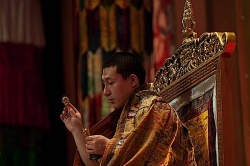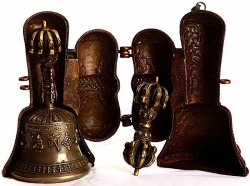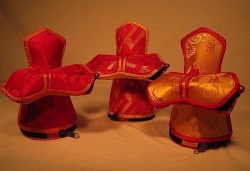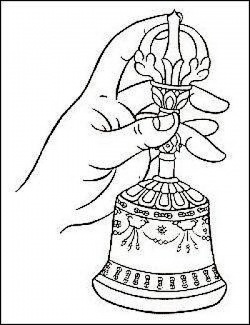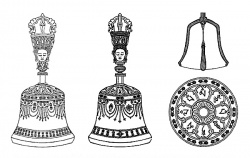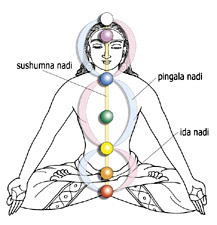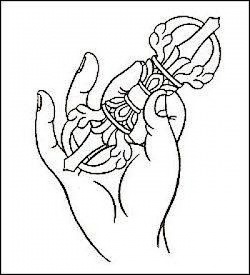Wisdom and Compassion—Ghanta and Vajra: Why the Bell and Dorje are Inseparable Symbols of Indivisible Emptiness and Form
The Bell and Dorje are virtually synonymous with advanced Vajrayana tantric practice. A Tibetan practitioner is rarely separated from these powerful meditational and ritual symbols—just as the Bell and Dorje should never be separated from each other. Even non-Buddhists might recognize the symbolism immediately—among the most widely recognized symbols used in Buddhism. (See video below for “How to use the Vajra and Bell”.)
But why does the Bell and Dorje hold such a prominent place in Buddhist practice? What is so special about these seemingly simple—yet endlessly profound—ritual implements?
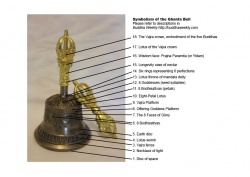
The Ghanta and Vajra, Bell and Dorje, represent multiple concepts (this list, compiled from various sources):
- Personal meditation Yidam deity (the Dorje), and your deity’s mandala (the Bell).
- The six perfections: the Perfection of Wisdom (Bell) and the five perfections of generosity, morality, patience, perseverance, concentration (the five prongs of the Dorje)
- The path to Enlightenment: Wisdom (Bell) and Compassion (Dorje)
- Bell and Dorje together symbolize the penetrating wisdom and compassion of the Heart Sutra.
- Sounds of Emptiness—sacred music and mantras—from the Bell and the forms of Enlightenment from the Dorje, including manifested Buddhas (five prongs representing five Wisdom Buddhas)
- Bell representing Dharmakaya Truth Body and Dorje representing both the Sambhogakaya Enjoyment Body and Nirmanakaya Transformation Body
- Great Mind (Bell) and Great Realization and Purity (Dorje)
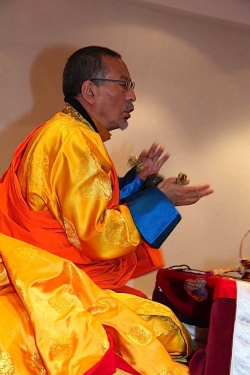
A Treasury of Teachings of Buddha Symbolized
Literally, each time we meditate with the Bell and Dorje we are engaging with a symbolic compendium of teachings of the Buddha. At the highest level, the very face of Wisdom—Pranjna Paramita—appears on the handle of the Bell.
In our hands, the Dorje is Yidam: compassion and method—representing the five male perfections; the Bell is Mandala: the entire wisdom Mandala and representing the female perfection of wisdom.
We cradle in our hands the deity, and the entire mandala of the deity, embodied in the subtleties of the symbols, or the entire universe itself—wonderful offerings for our practice. We touch the five Dhyani Buddhas and their wondrous wisdom consorts.
We also directly connect to the eight great bodhisattvas and their consorts. The eight auspicious symbols, the lotus throne, the moon disc, and a complex array of symbols perfectly adorn these small, vital implements. And, importantly, we generate the emptiness of sound, a sound that reaches out to our inner Buddha with the sound of Wisdom, and calls on the deities.
Hand Mudras: How to use the Vajra and Bell: This is a video featuring Ven. Thupten Donyo of the Gyuto Vajrayana Center of San Jose. In the class, Ven Donyo teaches you how to use the Vajra and Bell with your offering mantras.
Wisdom and Compassion, the Path to Enlightenment
At the purest and simplest level of understanding, some teachings indicate the Bell (Ghanta in Sankrit) represents the Perfection of Wisdom (Prajna Paramita, in Sanskrit)—wisdom, which directly realizes emptiness.
The Dorje, (or Vajra in Sanskrit), the bell’s inseparable companion, represents compassion, form and means (or method).
Simply put, they are inseparable symbols, because together they represent indivisible emptiness and form. Or, put another way, wisdom and compassion. In Mahayana Buddhism, both wisdom and compassion—together—are the path to Enlightenment.
The imagery, however, of these near ubiquitous ritual implements, is as vast as the discerning mind cares to penetrate.
Perfection of Wisdom
At the highest level, the Bell and Dorje together symbolize the penetrating wisdom and compassion of that most important of Sutras—the Heart Sutra.
“Form is empty. Emptiness is form,” proclaims Perfection of Wisdom Sutra. If the Dorje is form, the Bell is emptiness. Put another way, compassion and wisdom, the path to enlightenment.
As symbols and ritual implements, they are inseparable from the practitioner, in the same way form and emptiness are inseparable in the sutras. Traditionally, the Bell and Dorje must never be separated from each other, either placed together in a place
of respect, or held simultaneously by the practitioner, Bell in left hand (wisdom hand), Dorje in right (method hand). But—always together. Thought of another way, the Bell is the Feminine principle (wisdom) and the Dorje is the Male principle (compassion).
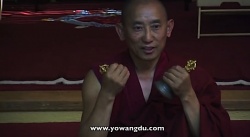
In the same way that the entire Heart Sutra can be represented by the great Perfection of Wisdom mantra—Gate Gate Paragate Para Samghate Bodhi Svaha—so, too, does the Bell and Vajra physically represent form and emptiness, compassion and wisdom.
Literally, the sound the Bell generates “proclaims the sound of emptiness.” The Bell also represents speech, sound and sacred mantras. Sound, as a metaphor for wisdom, suggests emptiness. In ancient belief, the relative universe arouse from a sound.
The Six Perfections
The five prongs on the classical five-pronged Dorje is said to represent the five “male” perfections (male=method) of:
- generosity
- morality
- patience
- perseverance
- concentration
The mouth of the bell, the open dome that generates the sound of emptiness, represents the sixth —and “female”—perfection of wisdom.
An Entire Universe in One Bell
The wonder of the Bell is the entire Deity Mandala contained within—and without. Contained is really the wrong word, since we’re talking about emptiness (wisdom)—but it’s the easiest way to describe symbols.
Literally, the entire relative universe—or in particular practices—the mandala of the Deity, is represented on the extraordinary Bell. Any serious practitioner will immediately recognize the symbols as the mandala of the deity.
Here are some of the many symbols found on traditional Bells (Ghantas). Please refer to the inset photo with labels pointing to typical position symbol will be found:
1. Disc of Space: the outer rim of the bell represents the outer disc of space.
2. Necklace of Light: as the bell tapers in in mandala shape, the first ring of malas or rosaries (pearls or conch) represent the outer protection circle of the Necklace of Light—protecting the mandala from conflagration (the poison of aggression), earthquakes (the poison of ignorance), and floods (poison of desire).
3. Vajra Fence: the second protective circle of the mandala as 32 or 65 upright Dorjes (Vajras).
4. Lotus Womb: the upper level of pearls or malas (surmounting the Vajras) is the third protective circle.
5. Earth Disk: above the Lotus Womb is an open, unadorned area, representing the disk of earth.
6. Eight Great Bodhisattvas: wrapped in a wondrous arcs and loops of jewels and pearls are the emblems of the eight great Bodhisattvas:
- Wheel (east or front)
- Uptala lotus (south east)
- Wish Fulfilling Jewel or Ratna (south)
- Wheel (south west)
- Lotus (west)
- Vajra (north west)
- Wisdom sword (north)
- Lotus (northeast)
7. Eight Faces of Glory: above the Bodhisattvas are eight faces of glory, and hanging from their fierce mouths are strings of pearls and jewels. These kirtimukha faces represent the eight makara heads of the immense Vishva Vajra (double Dorjes crossed) that supports the central mandala palace. In Chod practice, the eight faces also represent the eight great charnel grounds or cemeteries.
8. Offering Goddess Platform: the two rows of pearls above the eight faces represent the decorations of the offering goddess platform and walls.
9. Vajra Platform: The horizontal Vajras above the Goddess Platform represent the eight or sixteen emptiness’s and also the indestructible Vajra Platform, the material of the mandala’s central dais.
10. Eight-Petal Lotus: On the upper area of the bell is the lotus of the mandala’s central dais . On each petal is a seed syllable. The four cardinal syllables around the Lotus represent the Four Mothers, the consorts of the four directional Buddhas:
- Mother Tara (Tam)
- Mother Locana (Lam)
- Mother Mamaki (Mam)
- Mother Pandara (Pam)
11. Eight Male Bodhisattvas: Each petal of the Lotus represents the eight great male Bodhisattvas
- Kshitigarbha (East petal — east, the front petal of the lotus)
- Maitreya (southeast)
- Akashagarba (south)
- Samantabhadra (southwest)
- Avalokiteshvara (Chenrezig) (west)
- Manjugosha (northwest)
- Vajrapani (north)
- Sarva-nivarana-vishkambhim (northeast)
12. Eight Offering Goddesses: represented by the eight seed syllables (seed syllable English transliteration in brackets) between each petal of the Lotus:
- Lasya (Tam) offering beauty (east or front)
- Pushpa (Mam) offering flowers (southeast)
- Mala (Lam) offering garlands (south)
- Dhupa (Pam) offering incense (southwest)
- Gita (Mam) offering song (west)
- Aloka (Tam) offering light (northwest)
- Nritya (Pam) offering dance (north)
- Gandha (Bhrum) offering perfume (northeast)
13. Inside the lotus, surrounding the stem of the bell, is a smaller lotus of 24 or sometimes 32 spokes, representing the lotus-throne of the mandala’s central deity—you can visualize either Prajna Paramita, the face of the Perfection of Wisdom who adorns the bell, or the mandala of your Yidam deity.
14. At the base of the handle, and under the crowning vajra (which always tops the bell), are six more rings, representing the six perfections of the Prajna Paramita.
15. Between the three top rings and the three bottom rings is a square or round base, representing the longevity vase of nectar.
16. Above the vase, is the very face of wisdom, the ultimate wisdom Mother Pajna Paramita, wearing a five-wisdom jeweled crown and with her hair bound, representing the binding of all diverse views into a single non-dual reality.
17. Above the Goddess is the lotus base of the vajra crown. The vajra crown is the very embodiment of the Five Wisdom Buddhas: Akshobya, Amitabha, Amoghisiddhi, Vairochana, and Ratnasambhava.
Note: Some bells have a finger-whole, for the ring finger, replacing the longevity vase and sometimes the face of Prajn Paramita. This represents emptiness.
Symbolism of Prongs on Vajra or Dorje
Always held in the right hand, and never separated from the bell, is the Vajra or Dorje.
The main elements of a vajra include equal numbers of prongs on both ends, connected through a sphere or globe representing the sphere of actual reality (emptiness). The prongs (twin reflected vajras) are usually on lotus thrones, because the prongs themselves
most often signify the five Wisdom Buddhas on one end and their five Mother consorts on the other. The prongs include the central prong (four for the directions of west, north, east, west and the center). For other symbolism, related to the number of prongs, see “Many variations on the Vajra.)
At another level of symbolism, the two reflected ends of the vajra represent samsara and nirvana, connected by the actual reality of emptiness (sphere).
At yet another level of symbolism, the vajra in total represents the activity and compassion of the yidam, where the bell represented the yidam’s mandala.
Still another level maps the shape of the vajra to the map of the subtle body, with intersections representing nadis and chakras, and the perimeter lines mapping to the three main channels (see illustration.)
The center globe or hub represents dharmata (in Tibetan chos nyid) which is the sphere of actual reality—in other words emptiness. Whether inscribed, or visualized, the sphere contains the seed syllable (bija) of the syllable Hum.
Hum symbolism
The dharmata containing the Hum represents the three sounds symbolizing the groundlessness of all dharmas (subjective truths). These are H (Hetu) for freedom from causation (karma and samsara), U (Uha) ror freedom from conception, and M for freedom from transformation.
The closed prongs represent the perfection of the yidam’s method or skillful means (upaya in Sanskrit, thabs in Tibetan).
On both sides of the central sphere, are equal-numbered prongs (vajras) on thrones of lotus. The prongs themselves are normally square if viewed as a cross-section, rather than round, with the tips themselves coming to a point, like a jewel (or a pyramid).
Sometimes, the central prongs represent the subtle body (microcosm of the sentient being) while the four prongs surrounding represent the four directions and the four faces of Mount Meru (the symbolic center of the universe)—which together represent the universe (macrocosm).
Sometimes, on detailed vajras, we see four mouths of makaras (Sanskrit word, describing a sea dragon, a hybrid of a giant crocodile and fish) rising from the moon disc, from which the four surrounding prongs emerge—symbolizing the four immeasurables, the four doors to liberation, the four joys, the four directions and the four purified elements of fire, earth, air and water. Other vajras might have the prongs emanating from extended lotus petals.
The Lotus Thrones
The eight-petals of the lotus thrones, represent the eight great male Bodhisattvas and the eight great goddesses or female Bodhisattvas. The sixteen petals also represent the sixteen kinds of emptiness identified in the sutras.
On top of the lotus are circular flattened moon discs Above the lotus bases are three rings of pearls. The three rings on both ends, totaling six, represent the six perfections: generosity, morality, patience, energy, concentration and wisdom.
The Upper and Lower Prongs on Five-Pronged Vajra
Although an equal reflection, the exact duplicate of the five prongs on top and bottom (although technically, either can be top or bottom, depending on how it is held) represent manifold pairings of concepts:
- Upper—Five Wisdom Buddhas (Dhyani Buddhas); Lower—Five Mothers or Consorts
- Upper—five sensory perceptions; Lower—five sense organs
- Collectively: the ten directions, the ten perfections and the ten stages (grounds) of the Bodhisattva path.
The Upper and Lower Prongs on Nine Pronged Vajra
On the nine-pronged vajra (axis plus eight curving outer prongs on each end), the nine prongs represent:
- Four cardinal and four inter-cardinal directions on each end (N, NE, E, SE, S, SW, W, NW)
- Eight consciousness’s
- Buddha’s Eightfold Path
- Vajradhara surrounded by the eight great Bodhisattvas
- Mandala of the center and the eight directions.
Many Variations on the Vajra
There are many different types of Vajra. They basically fall into two broad categories. Those with “closed prongs” are suitable for all practices, while the “open prongs” are only meant for specialized practices, given out by a qualified teacher, and generally wrathful.
- Single Pronged Vajra
- Three Pronged Vajra: represents the Three Jewels (Buddha, Dharma, Sangha), and sometimes the three kayas (three bodies of a Buddha: Dharmakaya, Samboghakaya, and Nirmanakaya). It also symbolizes the overcoming of the three poisons of desire, aversion and ignorance and furthermore, control of the three times, past, present and future. It also symbolizes the three realms (below, upon and above). Finally, it represents the three main channels (nadi) of the subtle body.
- Five Pronged Vajra with closed tines (typically for Sarma traditions: Gelug, Sakya, Kagyu and Jonang): see main description above.
- Seven Prong Vajra
- Nine Pronged Vajra (typically only Nyimgma Tradition and Himalayan Buddhism)
- Twelve Pronged Vajra (vishvavajra), a crossed vajra or double vajra.
- Twenty Pronged Vajra (vishvavajra), a crossed vajra or double vajra.
